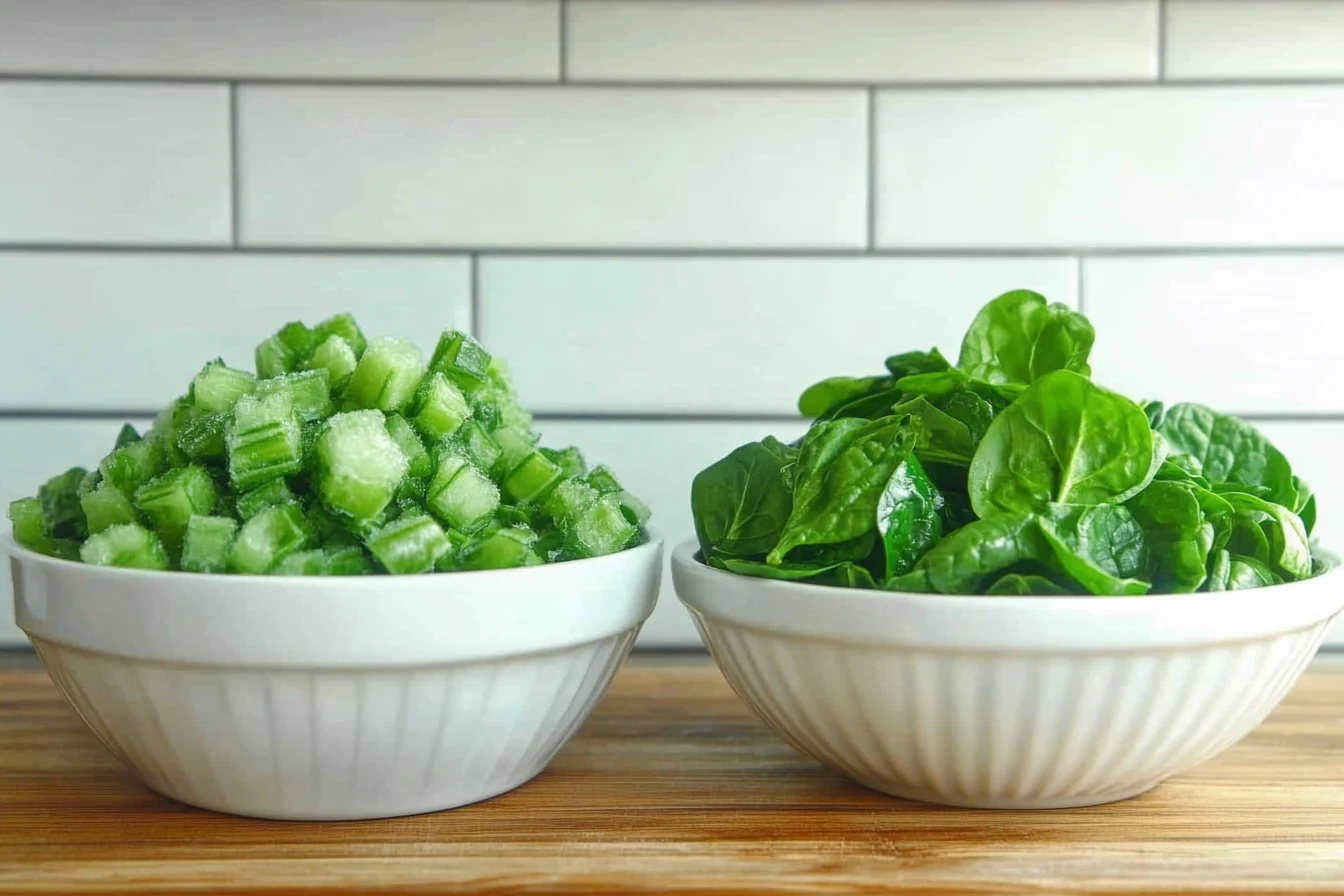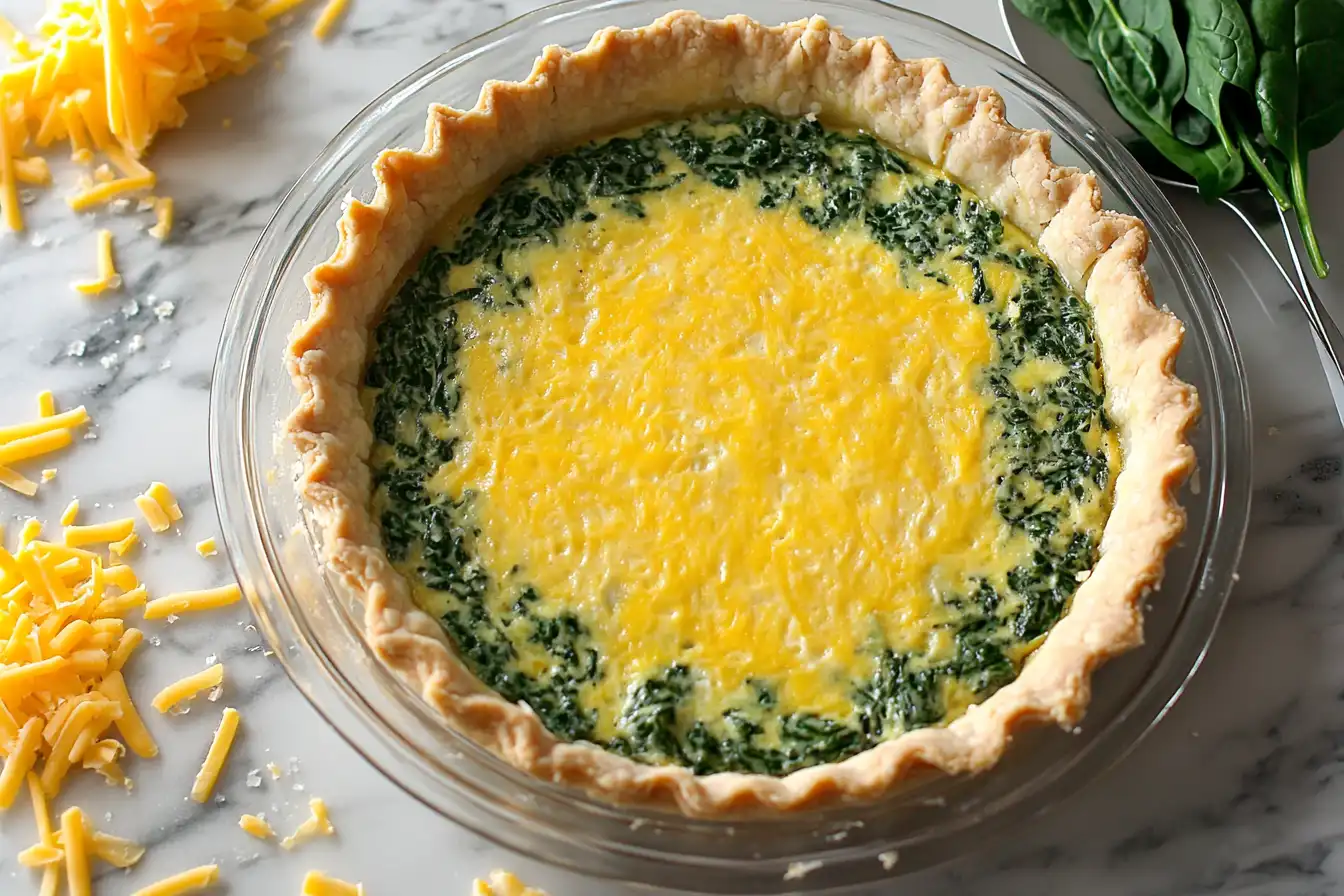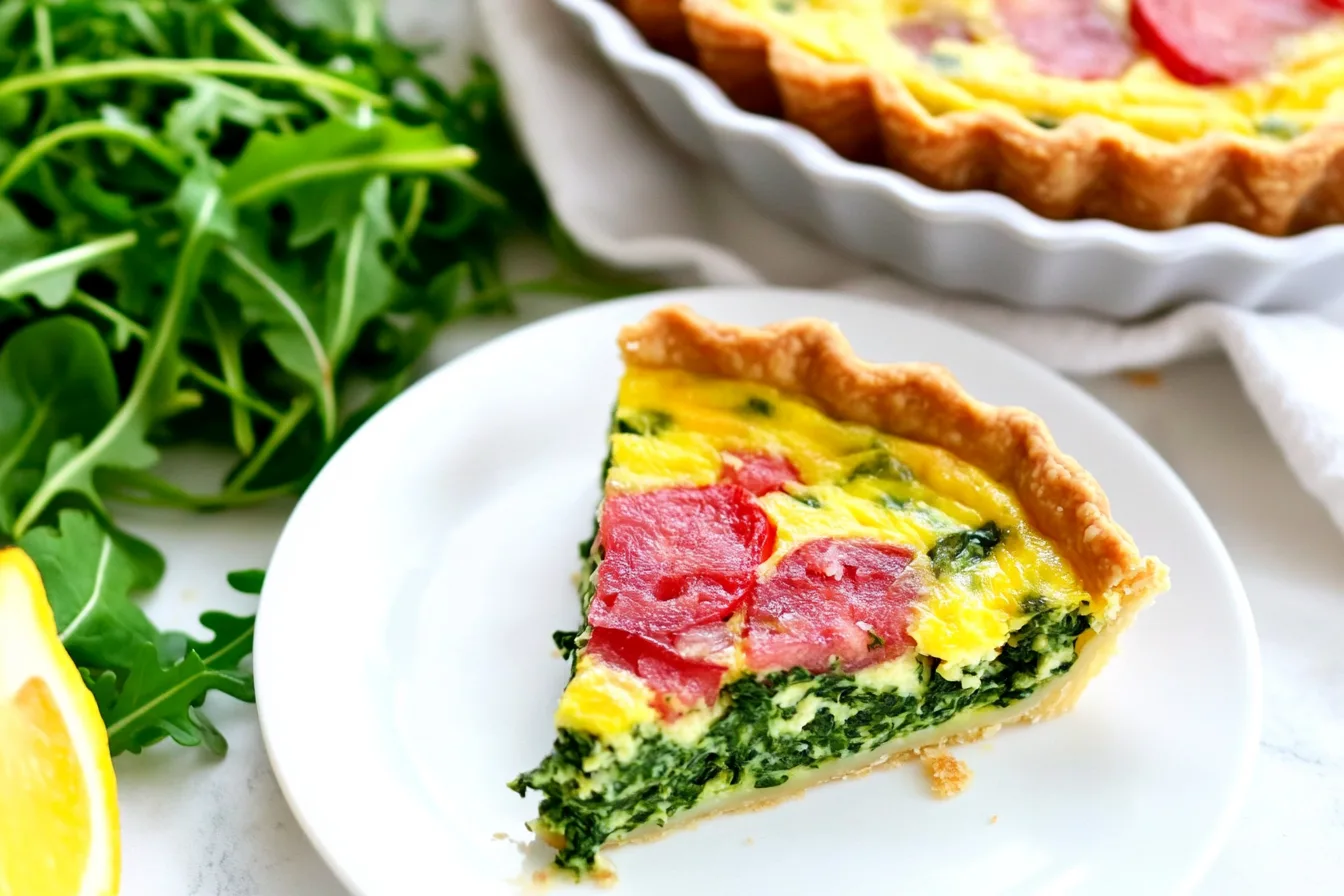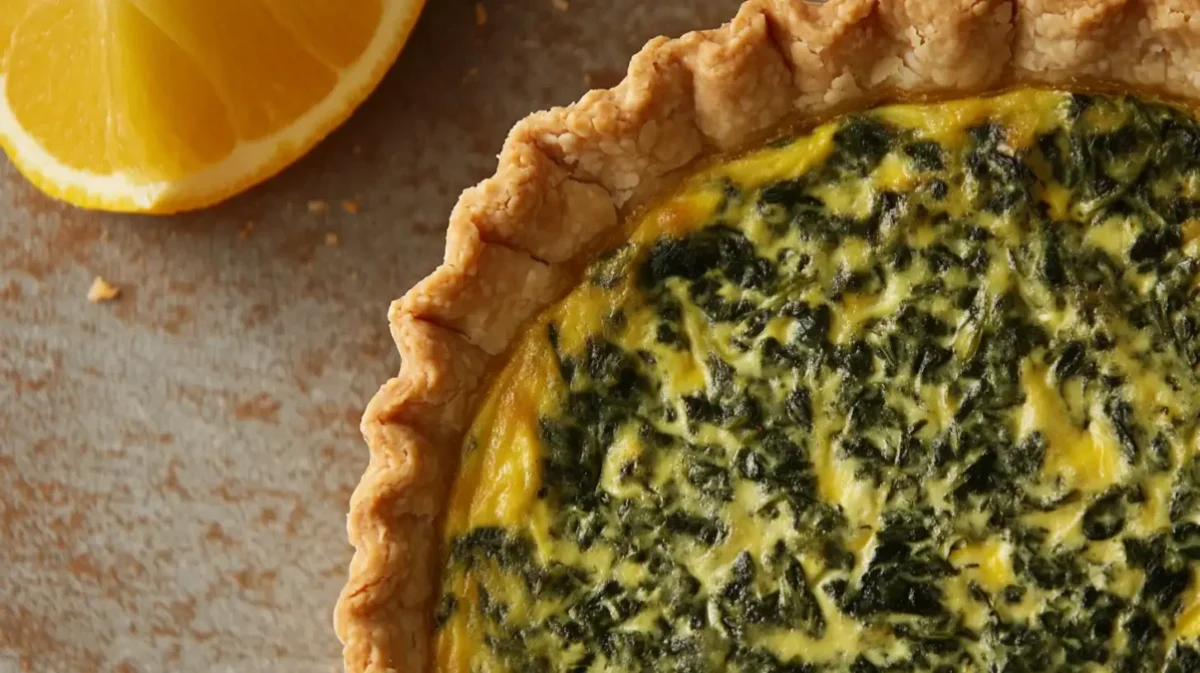Quiche has that magical ability to be both fancy and comforting at the same time. Whether you’re prepping for a laid-back brunch or planning ahead for weekday breakfasts, a homemade spinach quiche is a delicious, versatile, and filling choice that never disappoints. In this guide, you’ll learn everything you need to create the best homemade spinach quiche — from crust to filling and even flavor-boosting tricks you didn’t know you needed.
Table of Contents
Why Homemade Spinach Quiche Is a Game Changer
History and Origins of Quiche
Quiche might sound French—and it is—but its roots trace back to medieval Germany, where a dish called kuchen (meaning cake) laid the foundation for what we now know as quiche. Over time, the French adopted and refined it into the beloved, buttery pastry with egg and cream filling we adore today.
The traditional Quiche Lorraine featured bacon and cheese, but home cooks and chefs quickly embraced a world of variations. Enter: the spinach quiche. Combining leafy greens, melty cheese, and savory eggs, it offers a wholesome twist that feels indulgent without being heavy.
What Makes Quiche a Go-To Comfort Dish?
It’s the balance. Flaky crust, creamy center, and layers of flavor in every bite. Homemade spinach quiche delivers on several fronts:
- Versatility – Serve it warm, cold, or at room temp.
- Make-ahead friendly – Perfect for meal prep or gatherings.
- Customizable – Add cheese, herbs, or proteins to switch things up.
- Crowd-pleasing – Vegetarian-friendly and loved by all ages.
You get a dish that works for brunch, lunch, or dinner—without breaking a sweat. And the spinach? It sneaks in a serving of greens while adding texture and flavor.
Discover great ideas like this Chocolate Chunk Banana Bread for your sweet-and-savory weekend combo.
Ingredients Breakdown for the Best Homemade Spinach Quiche

Getting your ingredients right is the first real secret to mastering a homemade spinach quiche. The beauty of this dish lies in its simplicity, but the difference between good and unforgettable quiche? That’s all in the details.
Fresh vs Frozen Spinach: Which Is Better?
Here’s the truth: both work—but they serve different purposes depending on your time, texture, and flavor preferences.
| Type of Spinach | Pros | Cons |
|---|---|---|
| Fresh | Brighter flavor, firmer texture | Must be cooked, drained, and chopped before using |
| Frozen | Convenient, budget-friendly | Needs thorough draining to avoid excess moisture |
If you choose fresh:
- Sauté it first until wilted.
- Use paper towels or a clean kitchen cloth to squeeze out as much liquid as possible.
If you choose frozen:
- Thaw completely.
- Press out the moisture firmly to prevent a soggy quiche.
No one wants a watery filling. Moisture is the enemy of creamy.
Looking for inspiration? Try Strawberry Lassi alongside your quiche for a refreshing drink pairing.
Choosing the Right Cheese, Milk, or Cream
Here’s where the flavor magic really happens.
Best Cheeses for Spinach Quiche:
- Gruyère – Nutty and smooth, it melts like a dream.
- Cheddar – Sharp, bold, and a classic for comfort.
- Feta – Tangy and crumbly, pairs beautifully with spinach.
- Mozzarella – Mild and gooey, perfect for that stretchy bite.
Want to go all out? Mix two types. For example, Gruyère for creaminess and feta for a tangy kick.
Milk vs. Heavy Cream:
| Liquid | Texture | Flavor | Best For |
|---|---|---|---|
| Whole Milk | Lighter, still creamy | Subtle | Everyday version |
| Heavy Cream | Ultra rich | Deep, indulgent | Special occasions |
| Half & Half | Balanced | Medium | Best of both worlds |
Crust Matters – Choosing or Making the Perfect Base
The crust is more than just a holder—it’s your quiche’s first impression. A flaky, golden crust delivers crunch and contrast to the creamy filling. Mess this up, and no matter how good your spinach and cheese are, you’ll be left with a soggy, disappointing bite.
Should You Pre-Bake the Crust? Here’s Why It Matters
Short answer? Yes. Always.
Longer answer? Blind baking—that’s baking the crust before adding the filling—is essential to avoid the dreaded soggy bottom.
Here’s a step-by-step for pre-baking:
- Roll out your dough (store-bought or homemade).
- Press it into your pie dish, trim the edges, and prick the base with a fork.
- Line it with parchment paper and fill with pie weights or dried beans.
- Bake at 375°F (190°C) for 15 minutes.
- Remove the weights, then bake for 5 more minutes to dry out the bottom.
By pre-baking, you seal the crust, giving it structure and a little head start before the wet ingredients come in. That’s how you get a firm base that doesn’t flop when you slice.
Glass vs Metal Pans: Which Gives the Best Texture?
This choice might seem small, but it affects both texture and bake time.
| Type of Pan | Pros | Cons |
|---|---|---|
| Glass | Even heat, easy to monitor browning | Takes longer to heat up |
| Metal | Quicker bake, crispier crust | Can brown too fast or unevenly |
Verdict: If you’re new to quiche or worried about doneness, go with glass—you’ll see if your crust is golden. Want ultra-crisp results and confident with timing? Metal will give that satisfying crunch.
No matter your pick, don’t forget to lightly grease the pan, even if it’s non-stick. And let it cool slightly before pouring in your filling—this helps prevent leaks and cracks.
Don’t miss our Baked Cabbage and Potato Buns if you’re craving more savory pastry goodness. It’s a less-linked page worth exploring as a fun variation to classic baking.
Egg-to-Dairy Ratio – The Science of Quiche Filling
A quiche’s success doesn’t just rely on tasty ingredients—it depends heavily on texture. That perfect, silky center comes from getting the egg-to-dairy ratio right. Go too heavy on one or the other, and you’re left with rubbery eggs or a runny mess.
How Many Eggs Do You Really Need?
For a standard 9-inch quiche pan, you’ll want:
4 large eggs
+ 1 ½ cups of dairy (milk, cream, or both)
This combo fills most crusts evenly and results in a smooth, sliceable quiche. But here’s the golden rule:
1 egg per ½ cup of liquid dairy.
Stick to this rule and your filling will hold together beautifully—never too jiggly, never too firm.
If you’re making a deep-dish quiche, bump it up to 5–6 eggs with around 2 cups of dairy.
Pro Tip: Beat the eggs thoroughly to incorporate air. This gives the quiche its characteristic fluff.
Is Milk or Heavy Cream Better for a Creamy Filling?
We touched on this in Part 2, but now let’s talk ratios.
| Combo | Texture | Flavor | Best For |
|---|---|---|---|
| 100% Milk | Light and firm | Milder | Everyday breakfast quiche |
| 50/50 Milk + Cream | Balanced | Creamy and rich | Classic spinach quiche |
| 100% Heavy Cream | Super rich | Indulgent | Special occasions or dinner parties |
Want a healthy swap? Try mixing whole milk and Greek yogurt for protein and tang.
And don’t forget seasoning. Whisk in salt, pepper, a pinch of nutmeg, and even a tiny splash of vinegar if you want a bit of brightness (we’ll explain that more in Part 6).
Before you go on, discover this unique twist on savory baking: Cabbage Soup—a simple, comforting recipe packed with flavor.
Step-by-Step – Making Your Own Homemade Spinach Quiche

You’ve got your ingredients. Your crust is blind baked and ready. Now it’s time to assemble your masterpiece. This part walks you through the full quiche-making process—from prepping spinach to baking and testing for doneness.
Preparing Your Spinach, Crust, and Base
Start by prepping each component. Don’t skip this—it’s where good becomes great.
Step 1: Prep Your Spinach
- If using fresh spinach, sauté it in a skillet with a bit of olive oil until wilted. Let it cool, then squeeze out all moisture using a clean towel.
- If using frozen spinach, thaw completely and press dry with a towel or cheesecloth.
Step 2: Grate or Crumble Cheese
Whether you’re going with cheddar, feta, or Gruyère, grate or crumble the cheese now so it’s ready for layering.
Step 3: Mix Your Custard Base
Whisk together:
- 4 large eggs
- 1 ½ cups dairy (milk, cream, or combo)
- ½ tsp salt
- ¼ tsp black pepper
- Optional: ⅛ tsp nutmeg and a splash of vinegar
Mixing, Baking, and Testing for Doneness
Step 4: Layer the Quiche
Don’t just dump it all in—layer for flavor balance and even cooking.
- Sprinkle a portion of cheese on the bottom of the crust.
- Spread your spinach evenly.
- Add any extras (onions, mushrooms, etc.).
- Pour your egg mixture slowly over the top.
- Finish with the remaining cheese.
Step 5: Bake
- Place quiche in the oven at 375°F (190°C).
- Bake for 35–40 minutes, or until the center is just set but still slightly wobbly.
- You’ll know it’s done when a knife inserted near the center comes out clean.
Step 6: Cool Before Serving
Let the quiche rest for 10–15 minutes before slicing. This allows the filling to firm up and gives cleaner cuts.
Here’s a quick cheat sheet:
| Step | What to Do | Why It Matters |
|---|---|---|
| 1 | Sauté or drain spinach | Prevent sogginess |
| 2 | Mix custard base | Ensures fluffy texture |
| 3 | Layer ingredients | Better structure and flavor |
| 4 | Bake at 375°F | Even cooking, golden top |
| 5 | Rest before slicing | Easier serving, no mess |
Don’t miss our High Protein Breakfast ideas if you’re building out a full brunch menu.
Flavor Upgrades for Your Spinach Quiche
You’ve got the technique down, now let’s talk about making your homemade spinach quiche taste next-level. From bold cheeses to subtle herbs, small tweaks can create big flavor.
Best Spices, Herbs, and Cheeses to Add
Basic is fine—but gourmet is better. Here’s how to layer flavor into every bite:
🌿 Herbs:
- Fresh thyme – earthy, subtle
- Chopped chives – bright and oniony
- Parsley – fresh and clean
- Tarragon – adds a soft anise-like note (great with creamy cheeses)
🧄 Spices:
- Nutmeg – just a pinch adds warmth and depth
- Paprika – smoky or sweet for a rich backdrop
- Cayenne – a touch of heat wakes up the palate
- Black pepper – always grind fresh for best impact
🧀 Bold Cheese Combos:
- Feta + Parmesan – salty and sharp
- Gruyère + Swiss – nutty, buttery combo
- Goat cheese + Mozzarella – creamy with a tang
Pro Tip: Add sautéed onions, mushrooms, or sun-dried tomatoes to enhance umami. Just cook them down first to avoid extra moisture.
Here’s a flavor pairing table for quick wins:
| Ingredient | Boosts Flavor With | Why It Works |
|---|---|---|
| Spinach | Feta + Nutmeg | Creamy and earthy contrast |
| Mushrooms | Thyme + Gruyère | Savory, deep, and nutty |
| Onions | Swiss + Chives | Balanced sweetness and zip |
The Vinegar Trick: Why and How to Use It
This sounds odd, but trust us: a tiny splash of vinegar (½ tsp) in your egg mixture brightens up the filling. It cuts through the richness and makes the spinach taste fresher.
Which vinegar to use?
- White wine vinegar – mild and elegant
- Apple cider vinegar – slightly fruity, pairs great with cheddar
- Balsamic (a drop) – adds depth for meatier quiche variations
Don’t overdo it. You’re not making a vinaigrette. Think of it like a squeeze of lemon—just enough to lift the flavors.
Check out Strawberry Coulis: The Perfect Sweet Sauce as a fun side to sweeten up your brunch board.
Common Quiche Mistakes and How to Avoid Them
So, you followed the steps, used great ingredients… but something went wrong? Don’t worry. We’re diving into the classic quiche mishaps—why they happen and how to avoid them when making your homemade spinach quiche.
How to Avoid a Soggy Bottom
Ah yes, the dreaded soggy crust. It’s the #1 quiche complaint. But here’s the fix:
✅ Blind Bake Your Crust
As covered in Part 3, always pre-bake the crust before filling it.
✅ Use Dry Ingredients
Spinach, mushrooms, onions—they all hold water. Sauté or press moisture out before mixing them in.
✅ Add a Layer of Cheese First
Sprinkle a little shredded cheese right on the crust before adding the filling. This creates a barrier that helps lock moisture out.
✅ Bake on the Lower Rack
Placing your quiche on the lowest rack of the oven helps cook the crust from the bottom up, giving it a crisper texture.
Overbaking, Under-Seasoning, and Other Pitfalls
Let’s look at what else can go wrong and how to correct it:
| Mistake | What Happens | Fix |
|---|---|---|
| Overbaking | Rubbery texture, cracked top | Bake until center jiggles slightly—no more |
| Under-seasoning | Bland, flat flavor | Salt, pepper, nutmeg, and herbs matter—don’t skip them |
| Too Much Filling | Overflow, uneven cook | Stick to standard egg-to-dairy ratios (1 egg: ½ cup liquid) |
| Undercooked Add-ins | Crunchy veggies | Always cook and drain fillings first |
| Slicing Too Soon | Messy, runny quiche | Let it rest 10–15 minutes after baking |
Bonus Tip: Cover your quiche loosely with foil if it’s browning too fast on top but still jiggly in the middle. This protects the crust while the filling finishes.
And if you’re experimenting with crust alternatives, Baked Cabbage and Potato Buns offer a healthy dough base you might love for future bakes.
Serving, Storing, and Reheating Homemade Spinach Quiche

So, your homemade spinach quiche is golden, creamy, and smells incredible. Now what? Let’s cover how to serve it like a pro, keep it fresh for later, and reheat it without drying it out.
Best Sides, Serving Ideas, and Pairings
Whether it’s breakfast, brunch, or dinner, quiche plays well with others. Here are perfect pairings to round out your plate:
🥗 Light & Fresh:
- Arugula salad with lemon vinaigrette
- Cucumber and dill yogurt dip
- Fruit salad (strawberries, melon, mint)
🥖 Savory Add-Ons:
- Garlic toast or baguette slices
- Roasted potatoes or sweet potato hash
- Charcuterie board for brunch spreads
☕ Drinks:
- Coffee or espresso for brunch
- Citrus mimosas or herbal tea
- Sparkling water with lemon for lighter pairings
Planning a full brunch spread? Add something sweet like this Strawberry Lassi to balance out the savory.
How to Store and Reheat Without Ruining Texture
Quiche stores beautifully and makes an easy reheat meal.
🧊 Storing:
- Refrigerator: Store cooled quiche in an airtight container or wrapped in foil for up to 4 days.
- Freezer: Slice and freeze individual pieces, wrapped tightly. Lasts up to 2 months.
Pro tip: Place a paper towel under the quiche in the container to absorb any moisture and prevent sogginess.
🔥 Reheating:
| Method | Temp & Time | Best For |
|---|---|---|
| Oven | 350°F for 15–20 mins | Whole quiche or large slices |
| Air Fryer | 325°F for 8–10 mins | Crisp edges, small slices |
| Microwave | 60–90 seconds | Quick fix, but soft crust |
Avoid reheating too long or too hot—this dries out the eggs and makes the crust chewy. And never reheat frozen quiche without thawing it first for even results.
Don’t miss our High Protein Breakfast ideas to build a full meal plan that includes your quiche leftovers!
Variations to Try – Making Quiche Your Own
One of the best things about quiche? It’s endlessly adaptable. Once you master the basics, you can tweak, swap, and invent new combos that suit your taste, dietary needs, or simply what’s in the fridge.
Adding Meats, Veggies, and Going Crustless
You’ve got spinach and cheese down—but why stop there? Try these easy flavor boosters:
🥓 Add Protein:
- Cooked bacon or pancetta – salty and smoky
- Crumbled sausage – spicy or sweet
- Shredded rotisserie chicken – makes it a dinner option
- Smoked salmon – perfect for brunch
Just remember: always cook meats first and drain fat so they don’t make your quiche greasy.
🥕 Add More Veggies:
- Sautéed mushrooms – earthy flavor + meaty texture
- Caramelized onions – sweet and savory contrast
- Roasted red peppers – color + sweetness
- Zucchini or leeks – light and mild
🥚 Go Crustless:
Trying to cut carbs or gluten? Skip the crust altogether.
- Grease your pan well with butter or spray
- Add a tablespoon of flour or almond flour to the filling to help it bind
- Bake directly in the dish at 350°F for 35–40 minutes
It’s lighter, quicker, and still totally satisfying.
Gluten-Free and Dairy-Free Spinach Quiche Ideas
Whether you’re cooking for dietary restrictions or just mixing it up, here are options that work without sacrificing flavor.
🌾 Gluten-Free:
- Use a gluten-free pie crust (store-bought or almond flour-based)
- Or go crustless (see above)
🥛 Dairy-Free:
- Swap out cheese for dairy-free cheddar or mozzarella shreds
- Use unsweetened almond milk, oat milk, or coconut cream
- Add nutritional yeast to the egg mixture for a cheesy flavor boost
Flavor tip: Herbs like rosemary and thyme become even more important when you’re going dairy-free—they add depth and complexity to the filling.
Craving a dairy-free treat too? Chocolate Chunk Banana Bread can easily be made with plant-based swaps and pairs great with a savory dish like quiche.
FAQs About Homemade Spinach Quiche
What is the secret to a good quiche?
The secret lies in balance and technique:
- Use the right egg-to-dairy ratio (1 egg per ½ cup liquid).
- Blind-bake the crust to avoid sogginess.
- Cook and drain all wet ingredients (like spinach or mushrooms).
- Let it cool before slicing for clean cuts.
A creamy texture and evenly layered flavors are what separate a good quiche from a great one.
Can I use fresh spinach instead of frozen for quiche?
Absolutely. In fact, fresh spinach gives better flavor and texture. Just:
- Sauté it until wilted.
- Let it cool.
- Squeeze out all the moisture with a towel.
If you skip that step, you risk watering down your quiche.
Is milk better than heavy cream in quiche?
It depends on what you’re after:
- Milk creates a lighter, more everyday-style quiche.
- Heavy cream gives a rich, custard-like texture.
- Half & half is a happy medium.
For most home cooks, a 50/50 split of milk and cream is ideal.
Should a quiche crust be cooked first?
Yes—blind baking the crust prevents a soggy bottom.
Here’s how:
- Line crust with parchment and fill with pie weights.
- Bake at 375°F for 15 minutes.
- Remove weights and bake 5 more minutes.
This gives the crust a head start before you add your liquid filling.
Should quiche be in a glass or metal pan?
Both work, but:
- Glass pans allow you to see the crust and promote even baking.
- Metal pans heat faster and give a crispier bottom.
If you’re unsure, go with glass—you can monitor doneness more easily.
How many eggs do I need for a quiche?
For a standard 9-inch quiche:
- Use 4 large eggs
- Combine with 1½ cups of dairy
For deep-dish versions, scale up to 5 or 6 eggs.
How can I improve my quiche?
Upgrade flavor and texture with these tips:
- Use a mix of cheeses (like Gruyère + feta)
- Add sautéed aromatics (onions, garlic, leeks)
- Sprinkle in herbs (thyme, chives)
- Include a splash of vinegar to brighten flavor
And most importantly—don’t overcook it!
How to avoid a soggy bottom on a quiche?
Here’s your soggy-prevention checklist:
- Blind bake the crust
- Use dry ingredients only (squeeze spinach, drain veggies)
- Bake on the lower oven rack
- Layer cheese first, then add fillings
Following these steps ensures a crisp, firm crust every time.
How can I improve the flavor of my quiche?
Boost flavor with:
- A pinch of nutmeg or cayenne
- Layered herbs and cheese combinations
- Using bold cheeses like sharp cheddar or goat cheese
- Balancing richness with a dash of acid (like vinegar or lemon zest)
Flavor is all about contrast—so don’t be afraid to experiment.
Why do you put vinegar in a quiche?
It sounds odd, but a splash of vinegar (½ tsp) balances the rich egg and cream base.
It helps:
- Brighten the filling
- Enhance the flavor of spinach
- Cut through fatty cheeses
Use apple cider, white wine, or balsamic (just a drop) for depth and acidity.
Homemade Spinach Quiche That’s Simple, Savory, and Always a Hit
Whether you’re making it for brunch guests, meal prepping for the week, or just craving a cozy, veggie-packed meal, this homemade spinach quiche checks all the boxes: flaky crust, creamy filling, rich flavor, and endless customization options.
From understanding crust techniques to layering ingredients like a chef, you now have the tools to make a quiche that’s not just good—but unforgettable.
Don’t stop here. Looking for something sweet to pair with your savory quiche?
Don’t miss our Chocolate Chunk Banana Bread Recipe for a full brunch experience.

